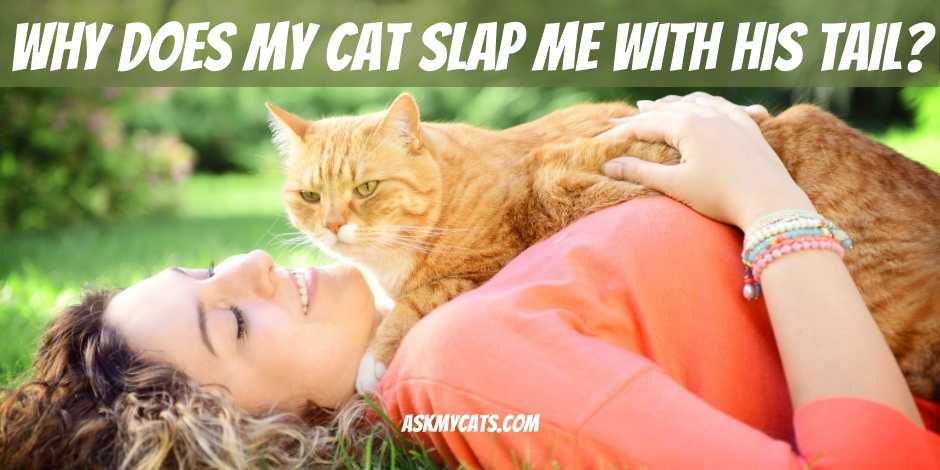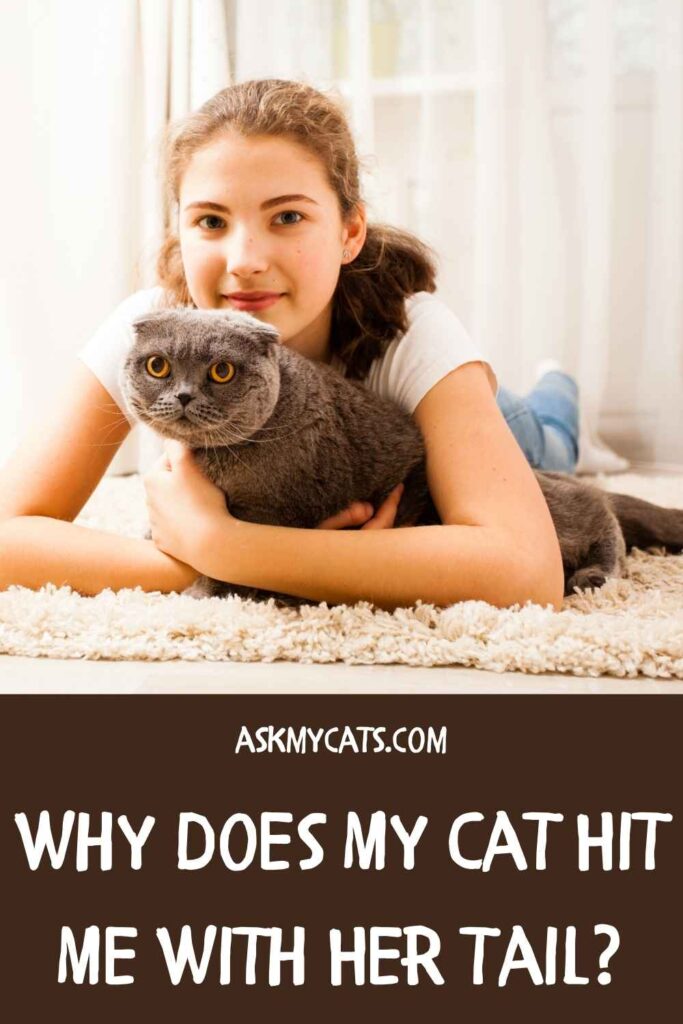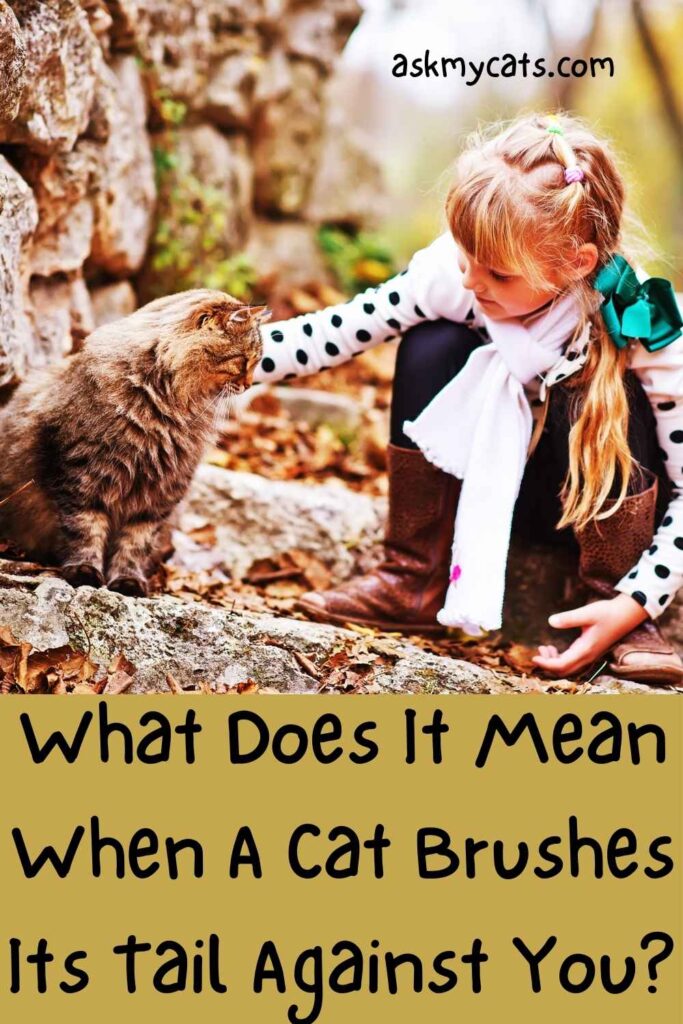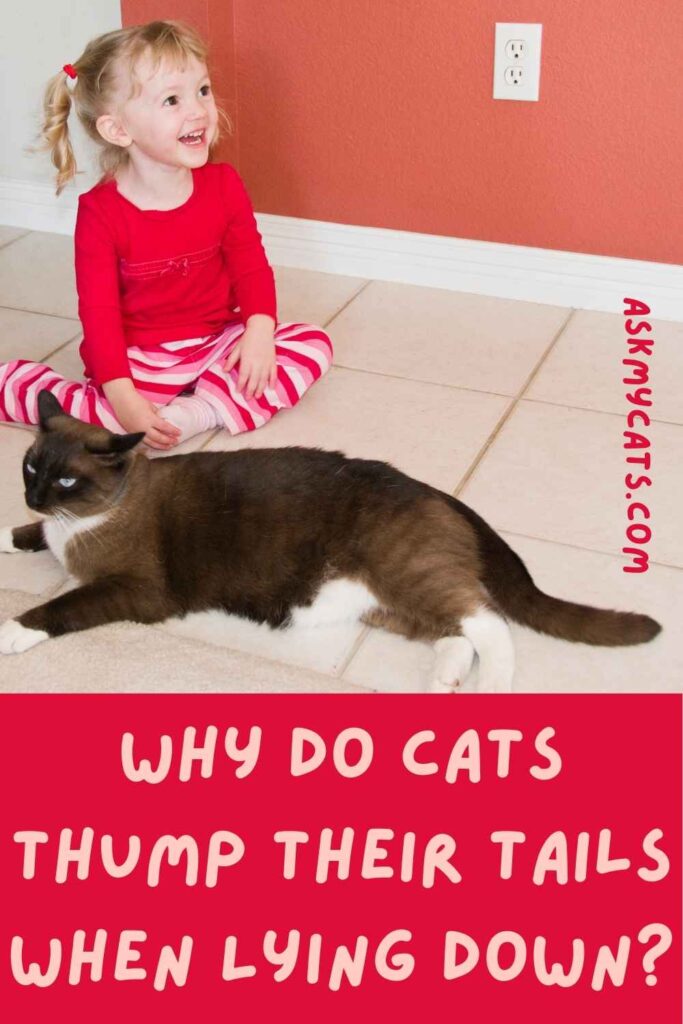Cat owners are closely tuned to the language of their cats, but sometimes the feline throws a curve. It is in their tails often.
The tail of your cat may tell you what is happening within her thoughts. Tails are favorable mood signs. Take a while to see the conduct of your cat and you will begin to have a feeling of the stories the tail says.
Cats use their tails and slap you with them to attract your attention. A cat’s tail can also indicate irritability, loneliness, love, anxiety, or hunger. This is a common way for cats to communicate and is not a cause for concern.
Let’s look at why cats are doing this and how you can follow your cat to see what they are attempting to say!


Give Your Cat the Perfect Day
Get the Free Ebook!
Why Does My Cat Hit Me With Her Tail?
Cats communicate in a variety of ways, and tail swiping is one of them. The following are some of the most common reasons cats strike you with their tails, as well as how to interpret them.

1. Stay Away!
The most possible reason why your cat is giving you a single flick of the tail to the leg indicates that you are in your cat’s way and should move.
Your cat will probably knock you down with his tail since he isn’t an animal fan, a pick-up, or anything he thinks you can cause harm “to it” when you come near to them.
Your cat has few methods to convey affection and few ways to express his changing moods. It is not unusual for the cat to wait until you sleep and whack his tail in your face.
Your cat may also strike you with his tail when you watch TV. They devise ways to communicate, and irritation is one of the ways they express their dissatisfaction.
Many cats knock things over, ruin furniture, and even have litter training to break into while using your bed or favorite chair.
2. Irritated Pet
Your cat will strike you with their tail in a succession of fast, sharp touches when they are furious. A fast flip of the tail is typically an indication that your cat is in distress.
If the tail of your cat is tucked, your cat may be irritated, agitated, or afraid instead of holding high.
Cats may sometimes, do not like the presence of humans at all. They express their disgust through movements of their body parts, like wagging their tail to and fro.
When you observe these types of signs in a cat, you can be sure that your cat is mentally disturbed and annoyed.
When cats are unable to reach the source of the attack by other animals, they may become aggressive in frustration. Many cats, for example, dislike having their bellies touched and have been known to be angry when petted.
You might also like to read reasons for cat wagging tail while purring
3. It’s Eating Time
If a cat is hungry, it will occasionally walk by and flick its tail angrily. This move is usually made with an intentional sense of haste; your cat is attempting to convey to you that they are looking forward to its next meal.
Cats usually eat at the same time each day and know when the time has come for their stomach sensation. Often cats are beginning to whine, whine, and even hit your tail to request food.
If you see your cat eating fast consistently or actions such as they battle over food, this may be a hint that it may be time to vary your normal meals or even take various portions of food into account.
This may be the symptom of a medical risk when the cat continues to eat ravenously even after you have modified its meals.
4. Playtime = Attention Time
If it’s an hour of the day when your cat generally has a lot of activity, they may come by and whack you with their tail to indicate that they want some attention.
Tail slapping is one of the preferred communication tactics of your cat to assist you to get out of sleep.
When your cat is happy to meet you, she may pursue you with her tail upright, with just the end of it making rapid, small vibrating jerks, comparable to a rattlesnake’s tail.
When a cat wants attention, he will go to great lengths to obtain it. And, though yours has his personality, he is likely to display some of the little needy cat behavior that many feline enthusiasts recognize, such as laying on his back for a belly rub or softly pawing at your arm.
5. Anxiety Kills The Cat!
When a cat is distressed about something, it will stoop down to the ground and swish its tail.
They could sit next to you, staring out the window and smacking you on the back with their tail. It’s an attempt to persuade you to look at what they’re looking at, but it’s usually nothing.
When you walk into a new room, your cat may wrap its tail around you. It’s a technique for them to feel safe, similar to holding your hand. They’ll follow you around the room, their tail wrapped around your waist.
They are frequently related to the things that make people uneasy, such as major changes in habits or surroundings. Moving house or adding a new member to the family might cause cats to get anxious.
If you’re caressing your cat and they start tail slapping, it’s an indication that they’re becoming tired of being touched. You are advised to stop it right there, or else your little kitty may transform into a big ball of fire!
6. Accidental Touch
Your cat’s tail may accidentally hit you from time to time.
Cats enjoy touching you accidentally because that’s how they can bother us, and that can become a great source of entertainment for them to see us bothered.
Cats enjoy being near their owners and may frequently scamper around beneath your feet while you work or move about your home. You are working and ignoring your poor kitty; this is not tolerable for them.
7. Your Cat Is Greeting You
To say hello, people shake hands or embrace each other, but cats can do the same thing with their tails.
Imagine you are coming back from a good long day’s work, and your cat welcomes you to the house by wrapping its tail around your arms.
What a delightful scene that would be! And that’s all a cat lover craves for!
8. Your Cat Is Angry
When your cat delivers a downward flick of the tail and swishes it back and forth, this is the expression to be wary of. If you see this, give your cat plenty of room to sort out its feelings.
Tail slapping can sometimes indicate aggressive or angry behavior in your cat. Stop caressing your cat when they start smacking its tail.
Cats may also swat you with their tail while you are watching television. They may want to play and see you focused on the screen rather than on them, leaving them disappointed.
Cats can also smack their tails to express their rage or irritation with other pets in the house.
If one cat wants to play but the other does not, the one that wants to play may slap its tail as a warning to the other feline not to approach.
Also, read about why do cats slap
What Does It Mean When A Cat Brushes Its Tail Against You?
When a cat brushes its tail on your body, it is leaving its aroma on your skin. When a cat does this, they leave its mark on you, claiming you as its own.

Cat has scent glands on its cheeks, front, and chin and is a type of marking without any territorial activity like spraying, as a basis for its tail rubbing against human beings, other cats, and things.
It is pleasant, calming conduct, and indeed the pheromones included in those scented glasses stem from synthetic feline pheromones meant to soothe frightened animals.
Of course, the marking of the fragrance does not endure forever; therefore a cat often goes back to refreshing its marking.
At the base of their tails, cats have scent glands. They rub against them and leave a trace of their aroma on you so other animals may recognize you as their person.
Cats seldom come into contact with strangers if they do not like them in the first place, and if they are not strongly attached, they are far less likely to stick against them.
Cats convey their smell when they brush against items. When your cat nuzzles or head-butts your face, the fragrance from glands in their cheeks is deposited. It’s almost as though they’re claiming ownership and we’re just one of their possessions.
The scent from their sides and tails is transferred to you as they weave over your legs, generally as you prepare to feed them. This behavior is also an efficient means of ensuring that they have your undivided attention.
When a cat crosses or wraps its tail over a section of your body, it is a friendly gesture. They may even flick the tip at you while lying close to you. The same as before, except if it’s in your face in the morning, they’ve probably worked out that it wakes you up so they can feed you.
They get all mixed up with each other when they like each other. Because we’re so much bigger, it’s difficult for them to get tangled up with us, so putting the tail against you is one way they express their devotion.
Cats have a bad reputation for moving their tails a lot when they’re upset or anxious, but this isn’t the case.
Cats will do this often, and you may discover they come to you the most on the days you’re away for the longest period.
This is because any scent they left on your body has now worn off, and they will return to rub up against you to guarantee they leave a new fragrance on your body.
Cats are more likely to rub up against you as a gesture of affection than as an indication of serious irritation.
Butting is a cat’s way of communicating with others. She identified you as one buddy by rubbing this portion of your body against one of you.
Furthermore, a cat might utilize head bunting to define its territory. On their chin, cheeks, forehead, and lips, felines have smell glands. When they massage your face, your cat spreads a distinct fragrance on you and makes you a companion.
Also, check out why does my cat wrap her tail around me
Why Does My Cat Hit Me When I Walk By?
When a person walks by, a cat may strike them as a display of authority and/or establish their territory.
The cat is amusing himself by playing with you. You could have a few scrapes on your calves as a result. Consider them to be love bites. When you lose a cat, the first thing you notice is a lack of movement around ankle level.
Males will play more actively, which makes a difference if you want to play as well—-don’t be too enthusiastic, or the cat will withdraw.
Cat owners who allow this sort of behavior to continue will have a rambunctious cat on their hands who exhibit aggressive behavior regularly. This is not safe nor should something a cat owner condone!
The following are examples of warning signs:
- Constant Taps on the Leg or Arm
- Quick Growl
- Aggressive Posture
Why Do Cats Thump Their Tails When Lying Down?
Cat behaviorists say that if a cat thumps its tail swiftly while lying down, it is time to back away, leave the cat alone, or give the cat some time to rest.

If you’re caressing your cat, she may be overstimulated.
If a cat’s tail swishes about wildly when they’re lying down, it’s an indication that they’re agitated. Petting them right now may result in a grumpy scratch or your cat abandoning the place. They aren’t in the mood to snuggle.
Your cat thumps its tail to express its dissatisfaction, and it wants you to comprehend what it’s saying. If you keep touching it, it will believe you are disregarding its visual clues.
Thumps on your cat’s tail are a warning indicator. It typically indicates that some activity, such as petting or grooming, has reached a saturation point.
The tails of play-fighting cats may also be seen writhing and pounding. This is most commonly observed during cat play sessions, and there is typically nothing to worry about.
If you observe your cat thumping her tail while lying down, but she also has bristling hairs down her spine and her ears pushed back, this might be a sign that you should stop the play sessions.
Cats are gregarious and sociable creatures that use their tails to convey and transmit complicated emotions.
When lying down, they may thump their tails to convey annoyance, and enthusiasm, or to let you know she’s had enough of the petting session.
It might also indicate that your cat is in discomfort and unhealthy and you should take him to the vet in the first place as a responsible pet owner.
Frequently Asked Questions:
Why does my cat swipe at me when I walk by?
Play aggressiveness and status-related aggressiveness are the two primary reasons why cats may act aggressively against people. When cats are frisky, they frequently assault their owners. Without malice, they’ll scratch or bite you.
Is it bad when a cat wags its tail?
A wagging cattail, unlike a dog, does not indicate that they are pleased to see you! A cattail can reveal a lot, and when it’s moving in a wag, it’s usually a sign that something or someone is bothering it. It’s possible that the cat is doubtful of something, but also excited or curious.
Is my cat petting me with his tail?
A cat sitting at your feet, softly hitting you with its tail, is most likely giving you affection in a similar way as stroking you. If your cat is attempting to imitate your friendly behavior, it might be a sign of profound love.
Final Words
Cats have a reputation for being undetectable, but they are not. The tail of a cat, for example, might reflect how it is feeling. A cat’s tail may disclose a lot about the secrets of its emotions.
While some people believe that a cat’s tail is employed primarily to express fury, this is not always the case. In cats, tail movement when lying down can be a highly informative kind of body language.
A cat’s tail may represent a wide variety of emotions, from intense enjoyment to severe concern. The more time you spend watching your cat, the more you will grasp what it is trying to tell you.
Feel free to share your thoughts in the comments section below!

MY CAT LOVES TUMMY RUBS, BUT WHEN I STOP SHE SMACKS ME GENTLY DOES THIS MEAN SHES HAD ENOUGH AN LET HER BE
Hello Donna,
Yes, it can be the way of your cat to tell you to stop rubbing. But spend more time with your cat and observe her body language each time to understand it better.
Happy Cat Parenting